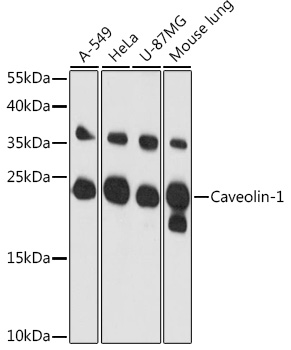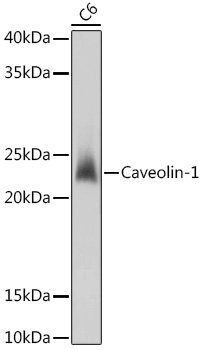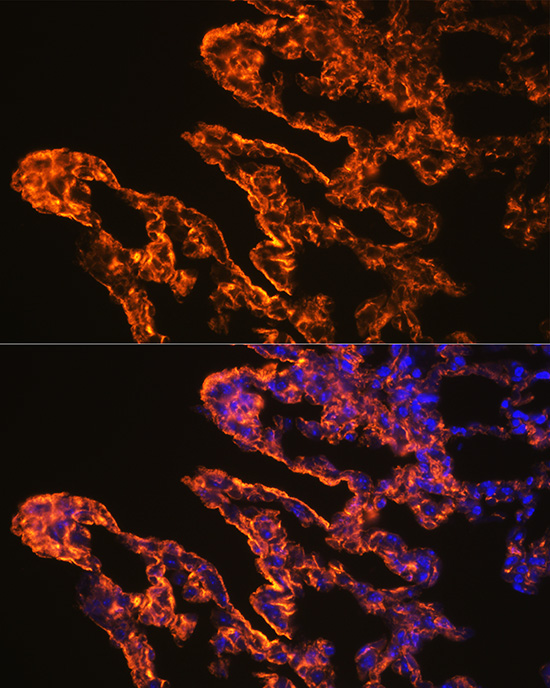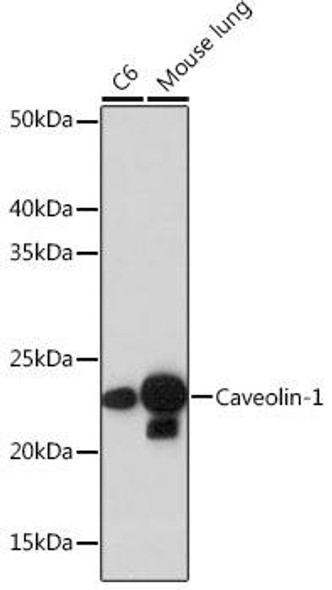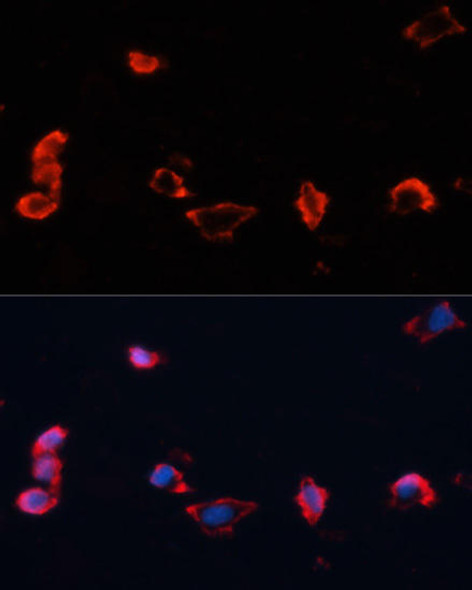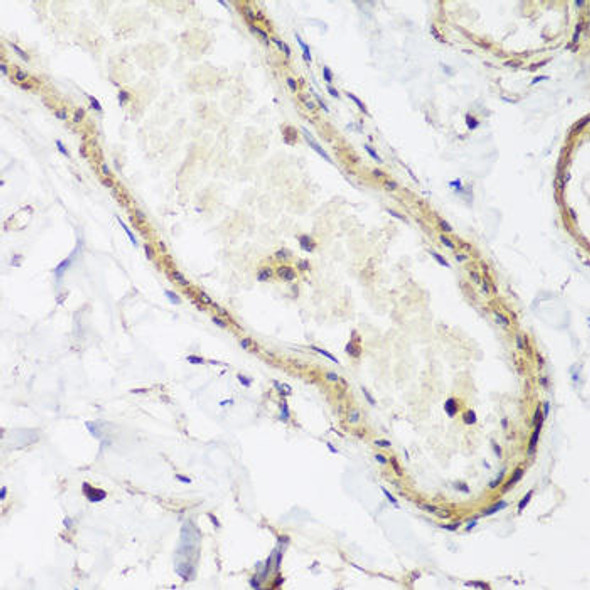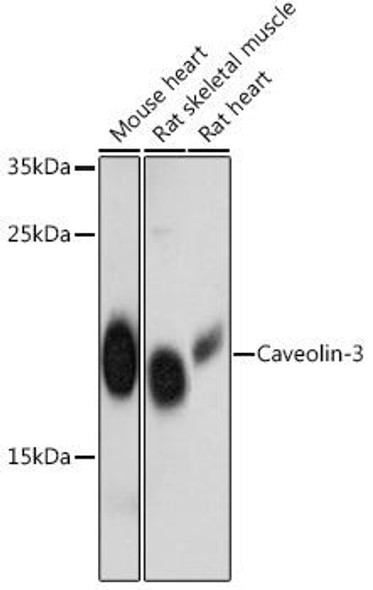Immunology Antibodies 3
Anti-Caveolin-1 Antibody (CAB1555)
- SKU:
- CAB1555
- Product Type:
- Antibody
- Reactivity:
- Human
- Reactivity:
- Mouse
- Reactivity:
- Rat
- Host Species:
- Rabbit
- Isotype:
- IgG
- Antibody Type:
- Polyclonal Antibody
- Research Area:
- Immunology
Description
| Antibody Name: | Anti-Caveolin-1 Antibody |
| Antibody SKU: | CAB1555 |
| Antibody Size: | 20uL, 50uL, 100uL |
| Application: | WB IHC IF |
| Reactivity: | Human, Mouse, Rat |
| Host Species: | Rabbit |
| Immunogen: | Recombinant fusion protein containing a sequence corresponding to amino acids 1-100 of human Caveolin-1 (NP_001744.2). |
| Application: | WB IHC IF |
| Recommended Dilution: | WB 1:500 - 1:2000 IHC 1:50 - 1:200 IF 1:50 - 1:200 |
| Reactivity: | Human, Mouse, Rat |
| Positive Samples: | A-549, HeLa, U-87MG, Mouse lung, C6 |
| Immunogen: | Recombinant fusion protein containing a sequence corresponding to amino acids 1-100 of human Caveolin-1 (NP_001744.2). |
| Purification Method: | Affinity purification |
| Storage Buffer: | Store at -20'C. Avoid freeze / thaw cycles. Buffer: PBS with 0.02% sodium azide, 50% glycerol, pH7.3. |
| Isotype: | IgG |
| Sequence: | MSGG KYVD SEGH LYTV PIRE QGNI YKPN NKAM ADEL SEKQ VYDA HTKE IDLV NRDP KHLN DDVV KIDF EDVI AEPE GTHS FDGI WKAS FTTF TVTK YWFY |
| Gene ID: | 857 |
| Uniprot: | Q03135 |
| Cellular Location: | Cell membrane, Golgi apparatus membrane, Membrane, Membrane raft, Peripheral membrane protein, caveola |
| Calculated MW: | 17kDa/20kDa |
| Observed MW: | 20kDa/23kDa |
| Synonyms: | BSCL3, CGL3, LCCNS, MSTP085, PPH3, VIP21, CAV1 |
| Background: | The scaffolding protein encoded by this gene is the main component of the caveolae plasma membranes found in most cell types. The protein links integrin subunits to the tyrosine kinase FYN, an initiating step in coupling integrins to the Ras-ERK pathway and promoting cell cycle progression. The gene is a tumor suppressor gene candidate and a negative regulator of the Ras-p42/44 mitogen-activated kinase cascade. Caveolin 1 and caveolin 2 are located next to each other on chromosome 7 and express colocalizing proteins that form a stable hetero-oligomeric complex. Mutations in this gene have been associated with Berardinelli-Seip congenital lipodystrophy. Alternatively spliced transcripts encode alpha and beta isoforms of caveolin 1. |
| UniProt Protein Function: | Caveolin-1: May act as a scaffolding protein within caveolar membranes. Interacts directly with G-protein alpha subunits and can functionally regulate their activity. Involved in the costimulatory signal essential for T-cell receptor (TCR)- mediated T-cell activation. Its binding to DPP4 induces T-cell proliferation and NF-kappa-B activation in a T-cell receptor/CD3- dependent manner. Recruits CTNNB1 to caveolar membranes and may regulate CTNNB1-mediated signaling through the Wnt pathway. Homooligomer. Interacts with GLIPR2, NOSTRIN, SNAP25 and syntaxin. Interacts with rotavirus A NSP4. Interacts (via the N- terminus) with DPP4; the interaction is direct. Interacts with CTNNB1, CDH1 and JUP. Interacts with BMX and BTK. Expressed in muscle and lung, less so in liver, brain and kidney. Belongs to the caveolin family. 2 isoforms of the human protein are produced by alternative initiation. |
| UniProt Protein Details: | Protein type:Motility/polarity/chemotaxis; Adaptor/scaffold; Nuclear receptor co-regulator Chromosomal Location of Human Ortholog: 7q31.1 Cellular Component: protein complex; focal adhesion; integral to plasma membrane; basolateral plasma membrane; endoplasmic reticulum; lipid particle; cell cortex; caveola; acrosomal membrane; cilium; lipid raft; Golgi membrane; early endosome membrane; perinuclear region of cytoplasm; apical plasma membrane; plasma membrane; intracellular; cytoplasmic vesicle; endosome Molecular Function:identical protein binding; protein binding; protease activator activity; enzyme binding; cholesterol binding; patched binding; protein complex scaffold; structural molecule activity; nitric-oxide synthase binding; protein kinase binding; receptor binding Biological Process: mammary gland involution; viral reproduction; negative regulation of epithelial cell differentiation; negative regulation of tyrosine phosphorylation of Stat5 protein; nitric oxide homeostasis; negative regulation of BMP signaling pathway; calcium ion homeostasis; protein localization; sequestering of lipid; regulation of the force of heart contraction by chemical signal; regulation of fatty acid metabolic process; negative regulation of protein binding; inactivation of MAPK activity; regulation of smooth muscle contraction; maintenance of cellular protein localization; skeletal muscle development; cytosolic calcium ion homeostasis; negative regulation of nitric-oxide synthase activity; cellular response to starvation; membrane depolarization; cholesterol homeostasis; response to estrogen stimulus; T cell costimulation; negative regulation of endothelial cell proliferation; negative regulation of protein ubiquitination; regulation of nitric-oxide synthase activity; response to calcium ion; response to progesterone stimulus; negative regulation of JAK-STAT cascade; leukocyte migration; lactation; vesicle organization and biogenesis; negative regulation of peptidyl-serine phosphorylation; negative regulation of pinocytosis; negative regulation of transcription from RNA polymerase II promoter; nitric oxide metabolic process; mammary gland development; calcium ion transport; negative regulation of cytokine and chemokine mediated signaling pathway; angiogenesis; vasculogenesis; protein homooligomerization; vasoconstriction; cholesterol transport; negative regulation of MAPKKK cascade; negative regulation of nitric oxide biosynthetic process; MAPKKK cascade; positive regulation of metalloenzyme activity; positive regulation of peptidyl-serine phosphorylation; regulation of peptidase activity; cellular calcium ion homeostasis; triacylglycerol metabolic process; regulation of blood coagulation; response to hypoxia; positive regulation of vasoconstriction; blood coagulation; vascular endothelial growth factor receptor signaling pathway Disease: Lipodystrophy, Congenital Generalized, Type 3; Partial Lipodystrophy, Congenital Cataracts, And Neurodegeneration Syndrome; Pulmonary Hypertension, Primary, 3 |
| NCBI Summary: | The scaffolding protein encoded by this gene is the main component of the caveolae plasma membranes found in most cell types. The protein links integrin subunits to the tyrosine kinase FYN, an initiating step in coupling integrins to the Ras-ERK pathway and promoting cell cycle progression. The gene is a tumor suppressor gene candidate and a negative regulator of the Ras-p42/44 mitogen-activated kinase cascade. Caveolin 1 and caveolin 2 are located next to each other on chromosome 7 and express colocalizing proteins that form a stable hetero-oligomeric complex. Mutations in this gene have been associated with Berardinelli-Seip congenital lipodystrophy. Alternatively spliced transcripts encode alpha and beta isoforms of caveolin 1.[provided by RefSeq, Mar 2010] |
| UniProt Code: | Q03135 |
| NCBI GenInfo Identifier: | 13637934 |
| NCBI Gene ID: | 857 |
| NCBI Accession: | Q03135.4 |
| UniProt Secondary Accession: | Q03135,Q9UGP1, Q9UNG1, Q9UQH6, |
| UniProt Related Accession: | Q03135 |
| Molecular Weight: | 178 |
| NCBI Full Name: | Caveolin-1 |
| NCBI Synonym Full Names: | caveolin 1, caveolae protein, 22kDa |
| NCBI Official Symbol: | CAV1 |
| NCBI Official Synonym Symbols: | CGL3; PPH3; BSCL3; LCCNS; VIP21; MSTP085 |
| NCBI Protein Information: | caveolin-1; cell growth-inhibiting protein 32 |
| UniProt Protein Name: | Caveolin-1 |
| Protein Family: | Caveolin |
| UniProt Gene Name: | CAV1 |
| UniProt Entry Name: | CAV1_HUMAN |


